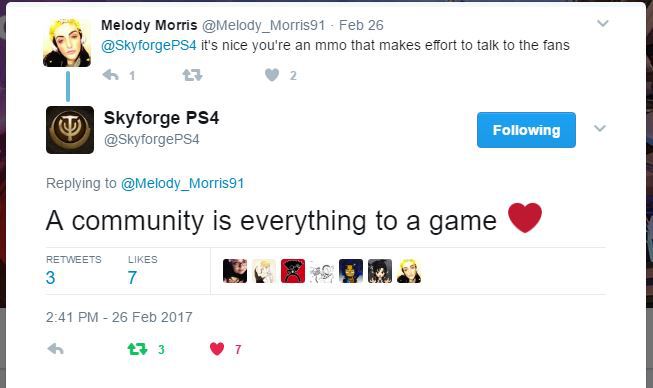What I’ve found in my time working with indie game communities is that very few game developers are in the loop in terms of what community engagement really entails. To most, it simply means posting when there’s an update or occasionally asking for player feedback on Discord. Maybe tweeting out when there’s a sale. In essence, anything involving irregular, impersonal posting.
However, this isn’t community engagement. This is a very small dot in the giant scope of things. I’d like to teach you all a thing or two about what you could, and should, be doing instead.
Let’s dive into player minds.
Understanding Your Audience

Players come in all forms. There are some who play a game and don’t care about talking about it online with anyone, including the developers. There are also those who do care to do this. Some like to feel like they know the people behind the game, while others care to learn more about the game instead. People like Melody, as illustrated above, notice when a studio makes an effort to talk to fans.
If we take a moment to think logically, the best form of player engagement is the kind that appeals to most, if not all, of the fans. Casting a wide net is important. That means posting both about the game, and about yourselves, as a studio. All encompassing information is sure to captivate more people than if you were to simply post game update announcements.
But here’s a burning question: Why do some players care about the faces behind the games? Much the same way as there’s a fascination with movie directors, or what singers do off the stage, society has a curiosity regarding those who create entertainment for the masses. While someone is out there working as a customer service rep or a cashier, developers get to brew coffee at home and start messing around in Unity. It makes most players wonder what development looks like, what goes on during those long hours.
And suddenly, the games you make aren’t just games anymore. They’re games made by (your name here), someone who thought of the idea for the game by (fill in your story here) and decided to make something special for people to enjoy. It becomes a personal thing, rather than just another contribution to capitalism.
Getting Out of Your Comfort Zone

Now, if the idea of posting your selfies and photographs of your messy desk make you shake in your boots, you’re not alone. In my line of work, any time I tell developers to break out of their shell, they emphasize how terrible they are at using social media in a personal way. Most feel comfortable being behind the security of a game studio, shrouded in mystery, much like camera operators.
And yet, as people who work in the games industry, making a form of virtual entertainment for countless of people, this can’t happen. The minute you decide to be a game developer, you have to accept the fact that you will be posting pictures—and interacting with your customers. Building that connection with them is a surefire way to strengthen friendships, gain valuable feedback, and even set the foundation of fandom for future projects.
Does this mean you get to post anything? Absolutely not. It’s entirely possible to display the faces behind the game while still being professional. Remember, the idea is to make the studio—and the work—seem more approachable. Never post about your personal struggles outside of work, or any irrelevant personal drama.
For more insight on blog creation, and the steps to consider when creating a new dev blog, scroll down!
Integration of Social Activity into Packed Schedules

Obviously, being a game developer means you always have something to do. More so for those with day jobs! The idea of adding community engagement to the schedule can seem impossible. Plus, can’t community managers handle that? Isn’t that their job?
Yes and no. If you work with a game publisher and get community engagement tips from someone like myself, expect to do your part. You’ll get tips and advice, feedback, and a list of ideas of approaches to take, but ultimately, you do it as a studio. The reasoning behind this is that those of us with another job title will not work solely on community. We wear many hats.
On the other hand, if you hire someone to specifically do community management, then you have someone to take care of all of this for you. As a bonus, this person would also monitor communities in-game, such as in MMOs. This person would make sure to keep toxic content to a minimum, oftentimes defusing player arguments. They would essentially be the brand cheerleader for you and ambassador for the players.
So, assuming you don’t want to put another person on the payroll, what are some ways to realistically up your social activity? Well, try to set aside a few minutes just two days per week. Even if it’s just twenty or thirty minutes, you can post on forums, Twitter, Facebook, etc.. Community engagement doesn’t require you to spend hours each day trying to talk to people. A few minutes per week to post about updates and ask for player feedback is a good start.
Aside from just updating on the game, ask for suggestions and take the time to reply to people. The idea is to start a conversation, not just state something and leave everyone hanging. And whenever there are no updates, post pictures of game development! What does the process look like for you? What’s your favorite mug, or your ideal way to prepare for the day’s tasks? Do you work at night, or during the day?
There is time for this, since you’re likely making time to work on your game. Whenever you’re working, and you’re doing something you’re especially proud of, simply take a picture and post it on the studio’s blog, or Steam forums.
Creating & Using A Blog As A Platform
Take it from us, the people behind all these blog posts: blogging isn’t as difficult as it may seem at first glance. There are several resources out there, predominantly written by bloggers, telling you how to do things, making everything out to seem so much more complex than it needs to be.
The truth is, with some light SEO and marketing effort each week, you can rank higher, and focus on what matters the most—your engagement with your audience!
Game developers often undervalue the power of a blog. It seems too difficult, or time consuming. Would people even care about it, or would it just become another dev blog, lost in the vastness of the internet? Well, that all depends on content, and yes, marketing. Do you think you can handle this list of to-do’s?
1. Consider Your Needs
Contrary to popular belief, the first step does not involve creating a blog. In fact, some reflection can save a lot of hassle in the long run. People who skip this part often lack direction in their blog and lose their audience as a result. So, first thing’s first: Consider your needs. What does your blog need to accomplish for you, and why? Why start a blog in the first place?
To quote Red Revolution, 9 strong multi-disciplined agencies specializing in web development, inbound marketing, and web application development:
“There are two types of blogging. The first involves people who blog for a living. They set out to become thought leaders in a particular niche, building a large and loyal following of readers who hang on their every word. The second type of blogging is what businesses do. Now it’s possible these blogs can also build a large following and be seen as thought leaders but to be honest that’s pretty rare. The chances of blogging for your business and building something huge are slim, but you can use it to generate interest in your company and generate valuable leads.”
Obviously, most game developers aren’t setting out to blog for a living. In fact, they just need a blog to generate interest in their game studio and creative projects. In the end, it’s all about getting more outreach and game sales.
So, if that’s clear, why is reflection needed? Because each game studio has different needs. Some have pretty large followings and require a blog to keep players updated on new content. Others need a blog to build that audience in the first place. Some game studios are good about having a voice, and others fall a little flat. What are your game studio’s needs?
2. Brainstorm Content

Next up, it’s time to brainstorm some awesome content ideas. Too often, developers think that posting about game updates is enough. Frankly, unless your sole objective is to do just that, you’re going to have to put in a little more creative effort into this. Nothing too extravagant, just simple, entertaining content. Easy to manage. Also, if you’re just writing about game updates, do it on Steam! That is great Steam content, but not enough for a blog.
Think creatively. It shouldn’t be difficult, since making games requires tons more effort than blogging. Think visuals and text, because blogs that are all about words come off super boring! Maybe videos and photos, some update announcements, and behind-the-scenes content. What does game development actually look like? Who are the faces behind the games? How did the studio come to be, and what is the mission moving forward? What does the studio, and everyone in it, want to accomplish in the next five years?
Whatever the content, make sure to stick with it unless you absolutely feel as though a change is necessary. This shows you’re reliable.
3. Think of Marketing
Newsletters, social media, Search Engine Opitimization, and blogging regularly. These are literally all you need to keep in mind for blog marketing. Upon creating an engaging dev blog, you might think this marketing thing is just a ploy. Someone is bound to read it if you just . . . post it. Right?
As much as we like to believe that good ideas will naturally find an audience, your un-marketed post will get lost in this little place where posts go to die. It’s very much the case of, “If a tree falls in the forest and no one is there to hear it, did it happen?” Sure it did, but no one was aware of it. Unless you tell people that you’ve created an engaging dev blog they should read, they won’t.
Luckily, this isn’t so difficult, mainly because game developers don’t blog for a living. It is important, however, to select a blogging schedule that is easily adhered to. It could be once a week, and it would be fine as long as it’s consistent. This means more time to create games, and less time spent blogging. It’s a win-win. It also might help to share the workload. Most indie developers work on remote teams, so why not assign the blogging task to everyone? Each week, a different voice and perspective. And once the post is done, tweet it out! Remind people on Facebook, and send out some newsletters to people who follow the blog.
If you don’t know how to create a newsletter, see this easy tutorial. It’s all about having a subscription form on the site, and then emailing people with new blog content once a week. A friendly reminder for people to read it. Many bloggers opt to write about upcoming posts, current posts, and valuable older blog content that got plenty of traction before.
As for SEO, remember it’s all about obtaining visibility on search engines, like Google. Use keywords that players would search for, like your studio’s name, the names of your games, “game development” or “game studio.” Another popular one is “dev blog.” Use tags to incorporate these keywords, but also select a 4-letter keyword to use within the blog post itself. If you can’t keep track of it all, here’s a solution: use Yoast SEO and fill in all the boxes until SEO shows up green!
4. Select a Platform

Selecting a platform to blog on can seem a little daunting. There’s WordPress, Blogger, Tumblr, Weebly, etc.. The thing to consider is where your audience is already. For many developers, they choose to create a blog on their official website. This works out quite well as websites with blogs tend to rank higher on searches than those without. The reasons for this tend to be all those backlinks, keywords, images, videos, and the fresh content. Google loves unique content.
But is the audience already on the official page? In all likelihood, yes. When they search for your games, or the studio itself, they should be seeing the official website as a top result. We humans love for things to be easy, so obviously, they’ll click into that, over something that is eight links down on the page.
Just keep in mind that every platform is different. Websites created on Weebly boast being able to drag and drop elements to create a custom website layout, but they feature no versatility in the actual blog design. Meanwhile, WordPress is a little more complex to use, assuming you go the coding route, but otherwise features beautiful layouts and plenty of blog customization options. It also features Yoast SEO, something Weebly does not. In fact, Weebly requires more work in the SEO department, because it’s not as simple as installing a widget to do the bulk of the work. So, if you’re using Weebly, and have no clue about SEO, use this guide.
5. Draw up a Layout Concept
. . . Or just pick one that really suits your game studio’s style and content. Remember, a layout isn’t just an aesthetic thing—it’s about functionality. A layout is supposed to take your amazing content, and put it front and center for the world to see. Readers shouldn’t be confused while navigating it. It shouldn’t be a maze just to find something specific. More so, it should not be impossible to find older content.
An engaging dev blog should feature a layout that makes players want to come back. The target audience isn’t likely the type to want overly simple, black and white. Nothing messy, but certainly more dynamic in approach. Maybe a slider featuring the latest news and announcements on the top of the page, with easily searchable categories on the sidebar. A grid-style where readers can simply click into a post, much like clicking a button, or a classic, scrolling layout?
Remember, it should feature a subscribe option on the top, and some social media buttons to make it easy to stalk the studio on Twitter! If you need some examples, consider some of these.
6. Create a Backlog

Now that the planning and setup stages are over, it’s time to create some backlog content. That means creating a few posts ahead of time, so that if there ever is an extraordinarily busy week, you’re not falling behind or rushing to get a post out in between a hundred other things. Assuming you post once per week, it’s a nice cushion to have anywhere from 4-6 posts backlogged. Don’t reach for the stars and write enough for months at a time, as it could lead to dated information. Things change all the time in game development.
It may also be smart to figure out a tone of voice for the blog. A style, so to speak. An engaging dev blog should always have a casual tone, very much reminiscent of the people behind the games. This is the same voice used when announcing updates. Keeping things similar plays up the studio as a cohesive entity in the eyes of the public. If you do decide to spread the work out among developers, keep this in mind. It’s perfectly acceptable to be original, but be original together. In other words, write in an easy, casual manner that everyone on the team can quickly do, and easily adhere to. Anything too demanding, and blogging becomes a hassle.
7. Keep It Easily Organic
Here’s a thought: What if blogging didn’t have to feel like a whole process? When people hear the word “blogging,” they often think of carefully curated content and meaningful posts. Lengthy, meaty posts, much like this one, chock-full of actionable information. While all of this is true, it doesn’t necessarily apply to an engaging dev blog. Players don’t want to read 2,500 words on how to do something, they want to know more about the studio and the games created by that studio. Some posts, like updates, aren’t meant to be meaningful.
So, what should your approach to blogging be? Engagement. The whole idea behind an engaging dev blog is to be just that—engaging. Players want to see the people behind the games, and they want to know what game development is really like. What crosses your mind as you develop these games? What challenges are faced, and what are you looking forward to? More so, they want to see the fun moments. Moments when things just flow, and the entire team has fun while being productive.
Why is all of this important? Because it puts meaning behind the games created. Because suddenly it’s not just another game by another game studio. It’s a game created by Sam and Tony, based around Ellie’s childhood nightmares.
And the most beautiful part about this is the fact that creating this type of content is already curated for your audience, and it’s easy to write. It’s easy to pick up your phone and take a picture, or record a video of what your work-space looks like. Let the ideas flow organically!
8. Social Media Is Your Friend

Finally, remember that social media is a friend. It’s there as a tool to connect with other developers and, of course, your fans. Players want to follow and get updated on things like maintenance, upcoming content, patches, and even those little jokes during development. It should become an extension of the blog itself. As such, it’s absolutely crucial that you not only extend that blog design to your social media accounts (same color schemes and tone of voice, for instance), but that you also make social media accessible from the blog. Adding social media links or buttons to the blog is a nice way of connecting everything the game studio does, while ranking higher on searches!
Think outside the box too, while analyzing the trends of the modern day and age. For instance, YouTube is a huge outlet used by streamers, players and even game developers themselves. When you create a video, don’t just post it on the blog, add it to YouTube too. Just make sure to link the blog in the description.
9. Consistency Is Key
An engaging dev blog isn’t all about actionable content, research, or tutorials. It’s about communicating with players and getting them interested in your work. If even one person cares about your game, or understands how much of a passion project it is to you, you’ve succeeded. Don’t be afraid to reply to those comments, post a link to the post on Steam to generate interest, or to tweet it out in hopes of making someone’s day. The people reading your content are likely the ones playing the games as well. Make friends, not just fans.
To do this, the best method to use is to consistently post. Stick to a posting schedule religiously, and keep blogging. Keep at it, even during those tedious weeks. Post about the difficulties you find along the way, even. As long as you persist, much like you are with the game currently in development, things will get done. And when you have more content to share, you’ll likely find you have some loyal readers.
It’s these people who want to know more about you, and the rest of the team. These are the people buying your games. The more you can engage with these people, the higher the chances of landing successful Kickstarters, pre-order campaigns, and sales. Just remember, don’t treat readers like another dollar sign. Sure, they make it possible for you to continue doing what you do, but ultimately, no one likes being sold something all the time.
Instead, focus on letting them get to know the people behind the game. What is the team all about? How did everyone meet, and will the studio continue to make games together for many years to come? Be personable, establish a connection, and watch that engaging dev blog grow into an outlet filled with memories, thoughts, worries, and achievements. Do it right, and it can grow into a mecca of information for both yourselves and the players. Journalists can spend less time researching the studio, and more time covering the projects. Fans feel like you care and like they can voice their feedback and concerns, all of which is completely invaluable to a game developer’s process.
Takeaways
Community is the backbone of a game. MMOs die when people stop playing. And single-player games get noticed and played when there’s a community behind it, whether it’s on Reddit, Steam or Discord. Without the players, there are no more games.
But beyond the simple law of supply and demand, there’s more to this. There’s a fascination with people like you, people who feel the desire to create something for the world to enjoy. Games mean so many different things to different people. They can be simple entertainment, or interactive fiction. An escape from the troubles of the real world, or a way to unwind after an especially difficult day. As a developer, you have a stage to use. There is always going to be someone out there who wishes you’d be more approachable.
So, will you carve out 20-30 minutes a week to make some new friends?
If you enjoyed this post and feel like you’ve learned something from it, remember to share it on social media! And as always, remember to follow or tweet us, @BlackShellMedia. We love making new friends!
